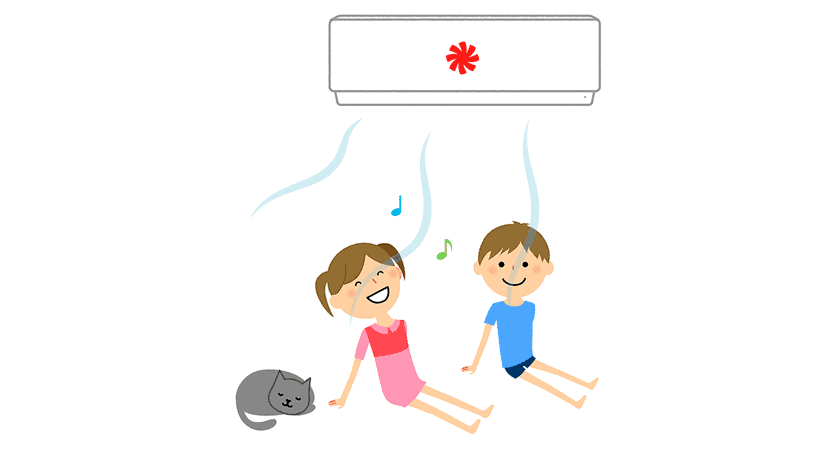Childhood is the most receptive stage in a person's life for assimilating concepts and acquiring habits. Therefore, from a very early age, we must teach our children to care for the environment and respect nature. Air conditioning and heating are synonymous with well-being and comfort in our homes. Learning how they work and when to use them is essential for responsible use of the planet's resources.
Air conditioning: well-being at home and at school
To understand how air conditioning units work, we must explain to children the relationship between room temperature and our own body temperature.
What is a comfortable temperature?
It's the kind of clothing we wear when we're neither hot nor cold. When we're at home, it's normal to wear comfortable, lighter clothing than the clothes we wear when we go out.
During the winter, children take off their coats, boots, and scarves and put on pajamas or a tracksuit. At this time, the temperature in the home should be approximately 21°C.
If it's summer, the temperature should be around 26º to be comfortable in a t-shirt and shorts.
What factors influence comfort temperature?
There are two parameters that influence the comfort temperature:
-
The outside air temperature
-
Relative humidity
The temperature outside will determine whether we wear more or less clothing. So in winter, we wear warm underwear, long-sleeved and long-pants clothing, coats, raincoats, and much more.
However, in summer we prefer lighter cotton clothing, with loose designs and short sleeves.
For this reason, the temperature at home, at school, and at work can't be the same throughout the seasons. In summer, it will need to be slightly higher than in winter so that we feel comfortable in the clothes we wear.
Mitsubishi Electric Air Conditioning
To understand how air conditioning machines work, it is necessary to know how gases behave under certain circumstances .
What is a refrigeration cycle?
It is a system that extracts heat from the room and replaces it with refrigerated air. In the refrigeration circuit, the refrigerant gas travels through the entire piping system while changing its state from liquid to gaseous and from gaseous to liquid. This change of state is what achieves the heat exchange that lowers the room temperature.
The most commonly used system is compression refrigeration, which we explain below.
What happens when a gas is compressed and decompressed?
Just like air, the gases used in air conditioners can be compressed, taking up less space. And when we do this, the gas heats up .
If we subsequently release the gas and allow it to occupy a larger space, it will lose temperature and cool down.
Through this system of alternating compression and decompression, we achieve that the air next to the gas and in contact with it lowers its temperature to the one we have specified.
Pro Tip: Experience comfort with professional central air installation in Garland TX. Trusted technicians, efficient systems, and affordable rates—schedule your install today!
Parts of an air conditioning system
For all this to work, air conditioning systems are made up of different parts:
-
Indoor unit
-
Outdoor unit
-
Refrigerant gases
-
Thermostat
The indoor unit is what we call a split unit , and you'll see it placed at the top of the rooms. It makes a very quiet noise when it's working and has a remote control with the necessary controls. It contains the evaporator and is responsible for extracting hot air from the room. It also has a built-in fan that you can set up as a fixed or mobile unit, depending on your needs.
The outdoor unit contains the compressor (to compress the gas) and a condenser to contain the gas as it converts to a liquid state. This unit is responsible for releasing the hot air to the outside.
Refrigerant gases are responsible for changing their state to absorb heat from the room and keep it cool.
The thermostat allows you or an adult to control the room's comfortable temperature. It also maintains the temperature by turning the system on and off.
What if we opt for Inverter technology?
In this case the mechanism will work in a more ecological way , regulating the speed of the compressor.
According to the system we have seen for how an air conditioner works, when the thermostat reaches the desired temperature, it automatically turns the device on and off to maintain it.
But with inverter technology, this doesn't happen. When the desired temperature is reached at home or at work, the inverter will cause the compressor to rotate continuously and maintain a constant temperature . This means considerable energy savings and, therefore, money on your electricity bill.
With an inverter air conditioning system, we can save up to 40% on energy compared to traditional systems. In addition, the compressor will last longer due to the labor savings it provides.
Quality: an essential requirement
With everything we've seen, you can imagine that higher-quality appliances are preferable to standard ones because they save not only money but also environmental resources.
We can summarize the whole process as follows:
-
When two gases come into contact, a heat exchange occurs: the colder gas heats up and the hotter gas cools down.
-
When we compress a gas, it heats up. If we decompress it, it cools down.
-
If you compress a gas and put it in contact with the outside, the gas acquires the temperature of the outside.
-
If you decompress it later, it will be colder than the outside.
-
This continuous system is what keeps our homes cool during the summer.
-
Air conditioning with an inverter system saves energy and money.
And finally, we must always keep in mind that air conditioning helps us maintain a comfortable temperature and feel comfortable at home and at school, both in summer and winter. We must use air conditioning responsibly to ensure it lasts a long time in perfect condition.



